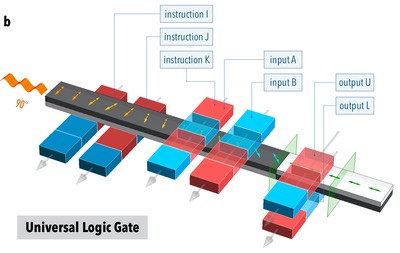The two main issues of the present computing technology are the increasingly severe energy dissipation and the limited computing speed. The origin of both issues can be traced back to the von-Neumann computing architecture, in which the data storage and processing are separately realized in the memory and the central processing unit (CPU). The necessity of communicating between them via the data bus, aka the von-Neumann bottleneck, not only decreases the computing speed, but also wastes significant amount of energy.
Spin-based technologies, nowadays mostly focusing on data storage such as the industrialized STT-MRAM and racetrack magnetic memories, are known for its high speed and non-volatility (thus energy efficiency). To overcome the von-Neumann bottleneck, we go beyond simply spin-based storage and introduce an in-memory computing structure of purely magnetic nature, which seamlessly integrates the memory and processing by employing the static magnetic texture for the data storage and its dynamical excitation – spin wave for processing. This in-memory computing architecture, utilizing the existing racetrack memories and synthetic antiferromagnet as its memory and processing components, is extremely simple in terms of hardware.
In order to realize the logic function, two physical mechanism we formerly studied are utilized: First. an antiferromagnetic domain wall or a magnetic gating structure can function as a spin-wave polarizer or a wave plate [1, 2], so that to realize the complete manipulation of spin wave polarization in a similar fashion as light. Second, an inverse effect of the polarizing effect, the response of an antiferromagnetic domain wall to injected spin wave is polarization dependent.

The proposed architecture of in-memory computing via spin waves possesses several competing features which may guide future computing in general: first, the five essential characteristics for logic applications are fully met, i.e. the architecture is ready to act as the basic building blocks for complicated logic devices such as a full-functional Arithmetic Logic Unit (ALU), the core part of a CPU; second, benefiting from the double-threshold domain wall motion behavior, a universal logic gate (see figure) is realized, i.e. all logic operations can be realized in one single hardware structure; last but not least, the architecture is an evolvable one, i.e. the architecture can dynamically evolve or upgrade itself, thus is capable of performing both conventional logic computing and the neuromorphic computing.
The highly interesting ideas described in the paper was mostly conducted by the former PhD student, Dr. Weichao Yu (now at Tohoku University in Japan), throughout his PhD study, with multiple versions of ideas on spin wave logic. The part on the magnetic gating was helped by the former Postdoc, Dr. Jin Lan (now at Tianjing University). This work was finally published on Physical Review Applied [3].
[1]. Lan, J., Yu, W. & Xiao, J. Antiferromagnetic domain wall as spin wave polarizer and retarder. Nat. Commun. 8, 178 (2017).
[2]. Yu, W., Lan, J. & Xiao, J. Polarization-selective spin wave driven domain-wall motion in antiferromagnets. Phys. Rev. B 98, 144422 (2018).
[3]. Yu, W., Lan, J. & Xiao, J. Magnetic Logic Gate Based on Polarized Spin Waves. Phys. Rev. Appl. 13, 024055 (2020).
